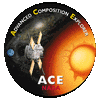

The goal of this investigation is to use theory and advanced computer modeling to help interpret data collected from instruments on board the Advanced Composition Explorer (ACE). Our primary objective is to clarify observations of cosmic rays (solar, anomalous, and galactic), ionized interstellar atoms (pickup ions), and key solar wind parameters, such as plasma velocity and interplanetary magnetic field. We will apply a variety of state-of-the-art numerical simulations and analytic theory, and will work with the various instrumental teams to meet these objectives.
This group is well situated to meet the goals of this project. We have extensive experience and are capable of tackling a wide variety of problems related to the ACE Mission. Our scientific tools, including analytic approaches, and unique numerical techniques such as our global cosmic-ray transport codes and multidimensional hybrid simulations, are well established. We have been involved with a number of investigations as Interdisciplinary Scientists and Guest Investigators for NASA's Heliospheric Missions. These investigations include: A) The study of the large-scale transverse magnetic fluctuations observed in the interplanetary magnetic field, particularly at high heliographic latitudes, predicted several years ago by Jokipii and Kota. B) The modeling of corotating variations in cosmic rays observed at the highest latitudes, and their relationship to the underlying magnetic and solar wind structure. C) Theoretical and observational studies of the propagation and acceleration of pickup ions, and their relationship to propagating phenomena corotating with the sun (corotating interaction regions, or CIRs).
In the present investigation, we will extend the above areas of research to consider composition, energy spectrum, anisotropies, and time variability, as well as move into some new areas. Specifically, we propose the following interrelated investigations: A) Model the heliospheric acceleration and transport of cosmic rays, using our existing and newly modified codes, with particular emphasis on the effects of heliospheric acceleration and transport on the elemental and isotopic composition of galactic and anomalous cosmic rays. B) Understand the transport and acceleration of pickup ions and their relationship to energetic nuclei in the solar wind, and their effect on the underlying solar wind and interplanetary magnetic field. C) Study the acceleration of low-energy thermal particles or pickup ions by shocks or by other interplanetary phenomena, using advanced hybrid and Monte-Carlo simulations, to determine the effects of this "injection" process on composition. D) Use our particle transport and Monte-Carlo codes to study the role of cross-field transport on the propagation of low-energy cosmic rays, including an assessment of the its role on the focussed transport of solar energetic particles. E) Study energetic particle events associated with solar flares and investigate the composition, spectra, and anisotropy for impulsive and gradual events. F) Determine cosmic-ray transport, especially that across the magnetic field, from comparing theory, numerical simulations and observations.
Throughout the project we will continue to look for observations and
phenomena which provide new insights and opportunities to extend our
understanding of energetic particles, plasmas and fields in the heliosphere.
Our Email Address: asc@srl.caltech.edu